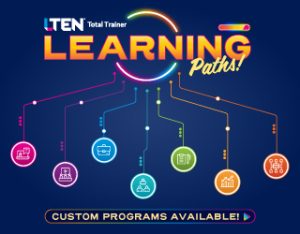
 Leadership – By Laura Last & Richard Baron
Leadership – By Laura Last & Richard Baron
You must plan for the future – then you have to sell it
 Every year that we get to lead training functions, we learn more and more about what the organization needs and how our training department can help drive success. Sometimes this even means changing how we execute our core responsibilities.
Every year that we get to lead training functions, we learn more and more about what the organization needs and how our training department can help drive success. Sometimes this even means changing how we execute our core responsibilities.
We may be introducing new and innovative programs or perhaps defining where we need to focus our efforts – which areas of the business, which skills, which roles. It’s the combination of these things that helps us define our vision for how the training function will move forward and how we can make an impact on the future success of the business.
Having a defined vision for the future is incredibly important. This is the foundation for how you rally your team and align your stakeholders with what you want to accomplish and what you may need from them to be successful. A great way to think about it is that your vision represents the horizon – it’s where you are heading.
As the leader of your people, you want everyone marching to the same beat and all pointing in the same direction. You want them to be fully bought into this path
forward and, therefore, clear on where they should be applying all their energy.
It supports their purpose and helps to motivate them. It also establishes a common language that can be used to hold one another accountable: “Is what I am doing
ultimately contributing to our overall vision?”
Build It & Sell It
Once you have your vision established, it’s incredibly important to invest significant time toward selling it to the organization.
The first step is to ensure your team and your supervisor are aligned with your ideas and plan. Once you have a clear idea of what the future needs to be, it’s
important to get input from your direct reports and your boss. Giving them a line of sight to your plans and the opportunity to comment and tweak is part of the co-creation process. This builds ownership within your direct up-and-down organization.
Even if you feel like you’ve created a solid vision and plan, you still want to share your ideas with your supervisor and team leaders (at a minimum) because they
may see things that perhaps you missed or may have new and different ideas.
You will want to spend a good amount of time with them to ensure they are aligned and bought in. They will need to understand the value of why it is beneficial not only for the business but also for them because people always want to know what’s in it for them – the WIIFM.
Your boss will also need to understand if you need more resources (money/headcount), a different structure or revised responsibility. Achieving a different future requires your supervisor to not only agree with the vision but to become a strong advocate who vocally promotes it across the business.
All Aboard!
With your team and your supervisor aligned, it’s time to take it to the business stakeholders and the masses. Back before television, presidents such as Abraham Lincoln all the way to Franklin Roosevelt took their vision to the people via “Whistlestop Tours.” They rode the rail lines across the country, stopping from town to town to give speeches selling their ideas.
Within our businesses, we often see this important step get missed, even though itis a critical part of change management.
The mistake that many leaders make is that they devise their vision or strategy and share it with their direct reports, requiring them to be responsible for communicating it in their own areas. Even with them being fully aligned and bought in, this game of telephone tag never works for a few reasons.
First, nobody knows or is more passionate about your plans for the future than you are. You have seen the opportunities and know what your team could do to make a difference – you cannot rely on your team members to sell it alone. They are a key part of the pull-through, but you need to own your vision.
Second, within a reporting hierarchy, people want to hear from the top. As a senior leader within your company, people will buy in more when they hear it coming from you.
This will require you to go on your own “Whistlestop Tour.” Meet with all of your key stakeholders. Go to their department meetings. Present to the most senior leaders at leadership and executive leadership team meetings. Sell.
A Matter of Timing
There are a few things to consider when sharing your vision for the next year and perhaps beyond. The ideal time to create this and sell your team is while your internal stakeholders are doing their annual business planning. Yes, you have an idea of what you want to accomplish, but it is critical that you know where the business is going so that you can make your story relevant and align with what is important to them.
You must be able to communicate the business impact of your plan. This helps you align and sell it to those stakeholders. It shows them that you know the business and reinforces the value you and your team bring to the organization.
So, timing and relevance are critical selling components. The other is the shape of the story.
Telling the Tale
Persuasive communication is a skill. There are ways to organize your story so that your key audience will not only be more receptive but will also be more likely to buy in.
One of the best methodologies is the pyramid principle, which is considered “the idea that changed McKinsey,” because once they implemented it, they won substantially more pitches than they had before, and the company grew into the powerhouse that it is today. This approach starts by customizing your story for each key stakeholder or stakeholder group.
- First, understand who you are communicating to, what is important to them and what challenges they are facing. This will enable you to adjust your story so that your vision speaks to their situation. To know what is important to them, you must be engaged with them on a regular basis.
- Next, lay out the challenges they are facing or will face in the future. You need to understand how these challenges will hurt them. It’s important to state these implications to get the audience emotionally vested in the problem. If you truly know the audience and their challenges, you will get their attention. This makes them receptive to hearing a solution that will help them.
- Finally, you introduce your vision and plans and talk about how they will help them to overcome challenges and achieve success.
Conclusion
In learning and development, we are focused on preparing the organization with the right competencies so that they can overcome business challenges and achieve successful outcomes. This starts by determining where to focus your efforts, what to implement, and how to execute.
Sitting between large functions like marketing and sales provides a unique viewpoint for us to see those gaps and opportunities quite clearly. This can make it incredibly frustrating to know what needs to be done and not be able to do it. That can change.
Build your vision for the future. Execute the roadshow to sell it. Communicate it concisely, logically and impactfully to successfully persuade your key stakeholders to buy in.
 Laura Last is head of global clinical operations learning &development for BeiGene, vice president of the LTEN Board of Directors and chair of the LTEN Learning Executive Committee.. Email Laura at laura.last@beigene.com or connect with her on LinkedIn at https://www.linkedin.com/in/lalast/. Rich Baron is principal of Framework Leadership. Email Rich at rbaronla@aol.com or connect with him on LinkedIn at linkedin.com/in/richbaron1.
Laura Last is head of global clinical operations learning &development for BeiGene, vice president of the LTEN Board of Directors and chair of the LTEN Learning Executive Committee.. Email Laura at laura.last@beigene.com or connect with her on LinkedIn at https://www.linkedin.com/in/lalast/. Rich Baron is principal of Framework Leadership. Email Rich at rbaronla@aol.com or connect with him on LinkedIn at linkedin.com/in/richbaron1.









